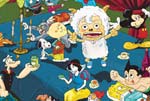Books
An encyclopedic account of Qing society
Updated: 2011-03-30 07:52
By Mei Jia (China Daily)
Critics such as Chen Fumin have drawn parallels to Shakespeare's works not only because of the Romeo and Juliet-like pairing of Jia and Lin, but also because of the novel's social sweep.
 |
Other comparisons include Japan's early-11th century The Tale of Genji by Murasaki Shikibu, and Russian writer Leo Tolstoy's Anna Karenina.
The novel provides an encyclopedic account of Chinese social structure and life in the 18th century through a combination of various traditional literary forms, including more than 100 poems.
By creating an unconventional male protagonist in Jia Baoyu, and by having female characters taking center stage in a patriarchal society, the novel breaks ranks with its contemporaries.
The interest it arouses is so huge that a whole branch of research into it called redology has emerged. From its rich archaeological content, researchers have been able to piece together such details of life in 1750s China as its tea and food culture, its festive routines, and its currency system.
Late chairman Mao Zedong, himself a poet, was a faithful reader of the book. Mao said he had read the book at least five times and is reported to have had at least 20 editions of the text on his bookshelf.
He quoted the novel frequently when giving speeches, and commended it as "a refined and precise record of social history".
The man who penned this classic is commonly believed to be Cao Xueqin. Researchers, though, have only a vague idea about the dates of his birth and death.
Cao seems to have intimate knowledge of a prosperous family's downfall and captures the extremes of emotions that changing fortunes trigger so well that the novel is often seen as semi-autobiographical.
Cao's family was connected closely to the Qing Dynasty (1644-1911) royal house. The family's wealth and power reached its height when Emperor Kangxi was in power from 1661 to 1722, with both Cao's great-grandfather and grandfather running the Royal Textiles in today's Nanjing, Jiangsu province, and serving as the emperor's eyes and ears in the south.
Cao's happy childhood ended when the family fell out of favor, when Emperor Yongzheng came to the throne (1722-1735). When the family house was confiscated in the 1720s, an impoverished Cao moved to Beijing.
The well-trained and talented writer then devoted himself to creating the novel, "word by word with blood and toil" as he put it, living on friends' support and the sale of his paintings.
He created a huge cast of nearly 1,000 characters from all walks of Qing society. Most of them have recognizable faces and features.
Jia Baoyu, for example, is heir to the wealthy and aristocratic Jia clan.
"Jia is a problematic teenager even judging by today's standards," says writer Liu Zhenyun. He resists studying the Confuciucian classics, disregards conventions, and enjoys the company of his cousins and playmates, mostly girls.
"Through him, Cao shows his courage in challenging social norms and authority," Liu says.
Lin Daiyu is a sensitive beauty, talented in music and poetry, who pays back her debt to Jia owed in a previous life.
Cao's female characters show great strength of character. For the first time they are not depicted as just wall flowers. They are shown as individuals who can think and talk in their own right, and are more capable than men.
This is best exemplified by Wang Xifeng, Jia's cousin sister-in-law, who runs the household with an iron fist.
The novel basically tells the tragic love story of Jia and Lin, which mirrors the decline of the Jia family. Written in the vernacular Chinese of those times, the book was banned during the Qing Dynasty for its perceived threat to social stability and for satirizing imperial rule.
Neither Jia nor the female characters were the hero type in 18th century Chinese society. Cao's emphasis on them ran counter to mainstream ideology.
The book largely survived through handwritten manuscripts.
The existing text by Cao is the first 80 chapters. Though he hints at a tragic ending, no one is sure about Cao's plan for the finale, encouraging numerous attempts at an ending. One of them is the 40-chapter one by Qing Dynasty writers Gao E and Cheng Weiyuan.
To sidestep the censors of his time, Cao resorts to numerous puns and allegories, like using the name Zhen Shiyin to imply truth is hidden, making reading the novel a rich and fun-filled experience.
As a national gold mine of literature, the book has been rendered into multiple artistic forms and languages.
It has inspired numerous dramas, paintings, ballets, operas, TV/film adaptations, and even cartoons and computer games. Some of the older productions are now collectors' items like the comic-strip books created in and before the 1980s.
Two English translations of the complete 120-chapter text are available. One is the five-volume The Story of the Stone by David Hawkes and John Minford, and the other the three-volume A Dream of Red Mansions by Gladys Yang and Yang Xianyi.
Hawkes employs a creative spelling of names - pinyin, English, French and Latin - to describe the characters who come from different social classes. The translation is highly readable as a literary creation in itself.
In terms of precision, the Yang couple's version impresses with both its understanding of Chinese culture and mastery of English.
Abridged versions by David Hawkes, Wang Chi-Chen and H. Bencraft Joly are also in print.
E-paper

Green mission
Tony blair believes China will take a leading role to fight climate change and cut emissions.
Stepping on to success
French connection
Generation gaps
Specials

Have you any wool?
The new stars of Chinese animation are edging out old childhood icons like Mickey Mouse and Hello Kitty.

Fill dad's shoes
Daughter and son are beginning to take over the family business of making shoes.

Virtual memorial
High-Tech touches to traditional tombsweeping festival help environment.
